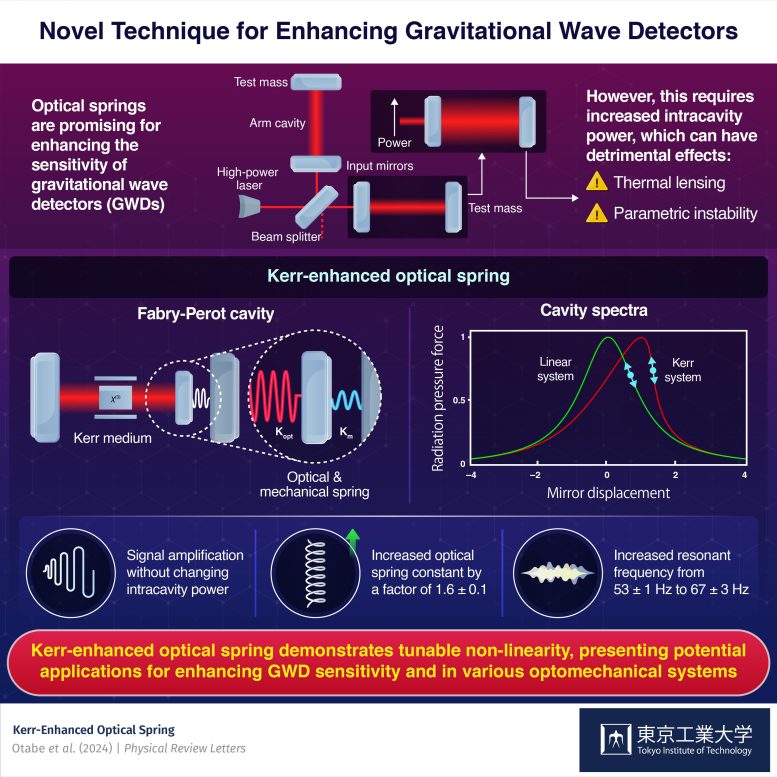
The Kerr-enhanced optical spring method enhances gravitational wave detection, offering new insights into cosmic phenomena and neutron star structures. Credit: SciTechDaily.com
Tokyo Tech’s development of Kerr-enhanced optical springs significantly boosts gravitational wave detectors’ sensitivity, enabling better detection of cosmic events and advancing our understanding of the universe.
The detection of gravitational waves stands as one of the most significant achievements in modern physics. In 2017, gravitational waves from the merger of a binary neutron star were detected for the first time which uncovered crucial information about our universe, from the origin of short gamma-ray bursts to the formation of heavy elements.
However, detecting gravitational waves emerging from post-merger remnants has remained elusive due to their frequency range lying outside the range of modern gravitational wave detectors (GWDs). These elusive waves hold important insights into the internal structure of neutron stars, and since these waves can be observed once every few decades by modern GWDs, there is an urgent need for next-generation GWDs.

Kerr-enhanced optical spring demonstrates tunable non-linearity, presenting potential applications for enhancing GWD sensitivity and in various optomechanical systems. Credit: Tokyo Tech
Enhancing GWD Sensitivity With Optical Springs
One way to enhance the sensitivity of GWDs is signal amplification using an optical spring. Optical springs, unlike their mechanical counterparts, leverage radiation pressure force from light to mimic spring-like behavior. The stiffness of optical springs, such as in GWDs, is determined by the light power within the optical cavity. Thus, enhancing the resonant frequency of optical springs requires increasing the intracavity light power which, however, can result in thermally harmful effects and prevent the detector from working properly.
To address this issue, a team of researchers from Japan, led by Associate Professor Kentaro Somiya and Dr. Sotatsu Otabe from the Department of Physics at Tokyo Tech, developed a groundbreaking solution: the Kerr-enhanced optical spring.
“A promising method to enhance the impact of optical springs without increasing intracavity power is intracavity signal amplification. This technique enhances the signal amplification ratio of the cavity by using non-linear optical effects and enhances the optical spring constant. Our research revealed that the optical Kerr effect is a promising approach for successfully utilizing this technique,” explains Prof. Somiya.
Their findings were published in the journal Physical Review Letters. In addition, this letter has been selected as an Editors’ Suggestion, a weekly recognition aiming to promote interdisciplinary engagement.
Innovative Approach and Its Implications
This groundbreaking design involves generating intracavity signal amplification effect in a Fabry-Perot type optomechanical cavity by inserting a Kerr medium. The Kerr medium induces an optical Kerr effect in the cavity, in which an optical field changes the refractive index of the medium. This introduces a drastic gradient of the radiation pressure force in the cavity, enhancing the optical spring constant without increasing intracavity power.
Experiments revealed that the optical Kerr effect successfully enhances the optical spring constant by a factor of 1.6. The resonant frequency of the optical spring was increased from 53 Hz to 67 Hz. The researchers anticipate an even larger signal amplification ratio with refinement of technical issues.
“The proposed design is easy to implement and provides a novel tuneable parameter for optomechanical systems. We believe that demonstrated technique will play a key role not only in GWDs but also in other optomechanical systems, such as in cooling macroscopic oscillators to their quantum ground state,” says Dr. Otabe, emphasizing the importance of this study.
Overall, this novel optical spring design represents a significant stride towards harnessing the full potential of optomechanical systems as well as enhanced GWDs capable of unraveling the mysteries of our universe.
Reference: “Kerr-Enhanced Optical Spring” by Sotatsu Otabe, Wataru Usukura, Kaido Suzuki, Kentaro Komori, Yuta Michimura, Ken-ichi Harada and Kentaro Somiya, 4 April 2024, Physical Review Letters.
DOI: 10.1103/PhysRevLett.132.143602









Be the first to comment on "Unlocking the Universe: Kerr-Enhanced Optical Springs for Next-Gen Gravitational Wave Detectors"